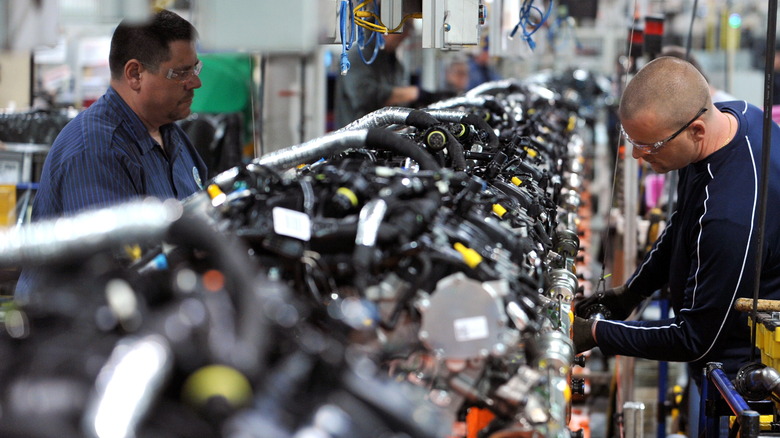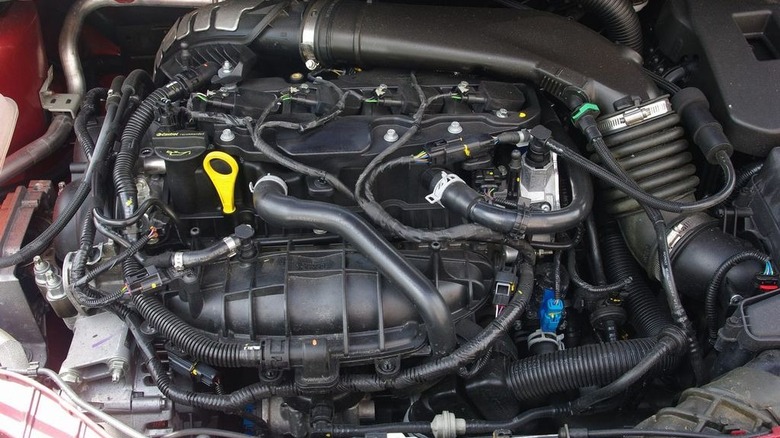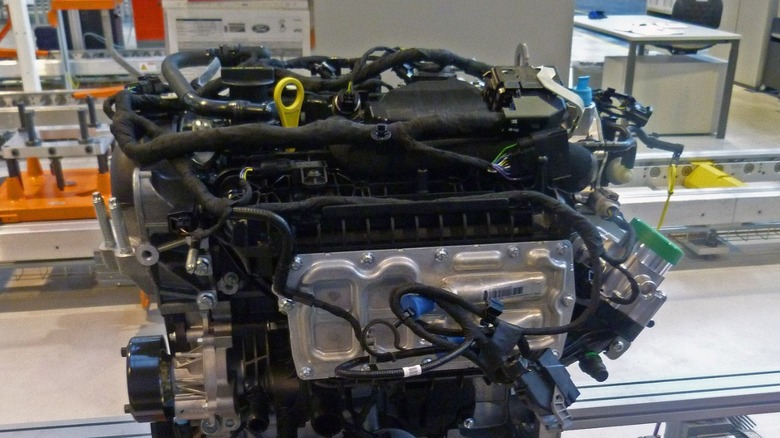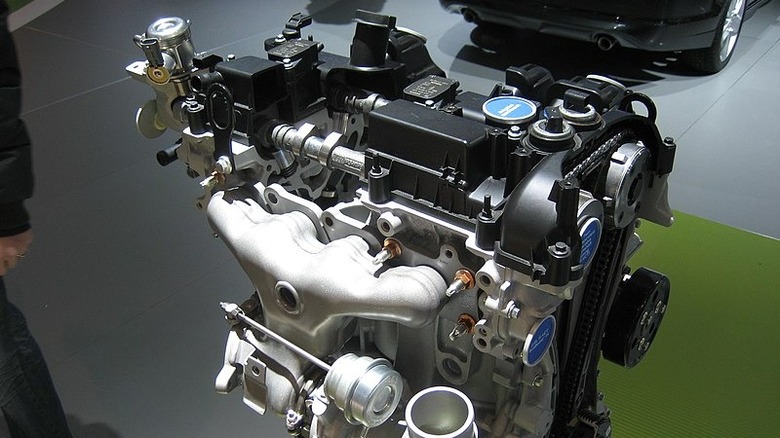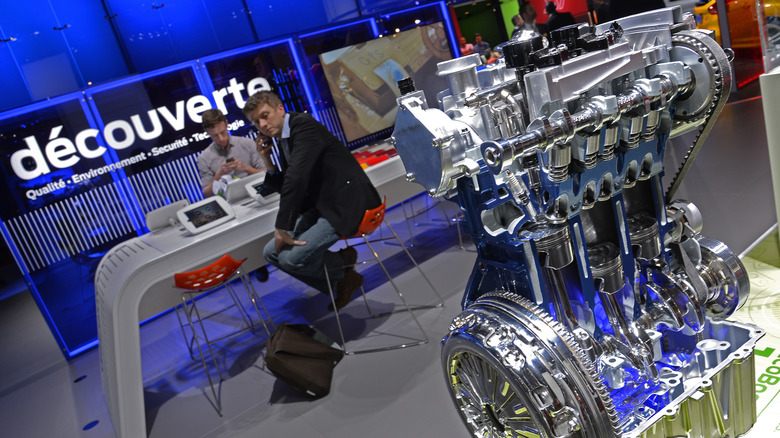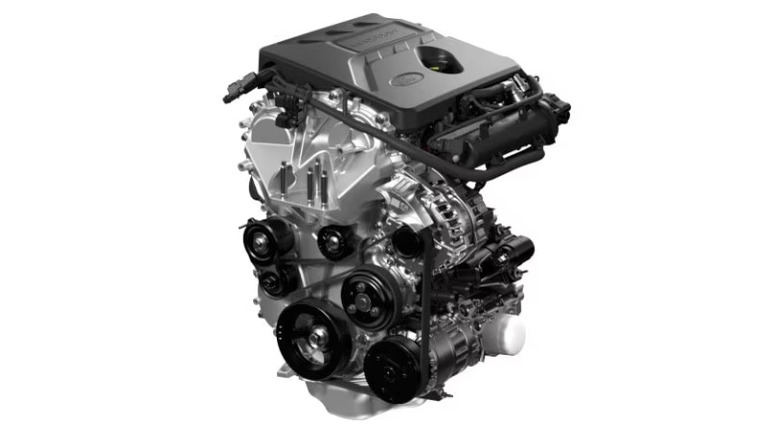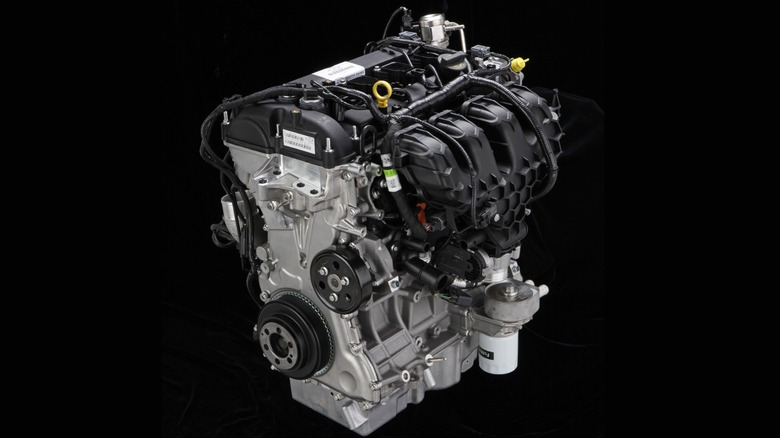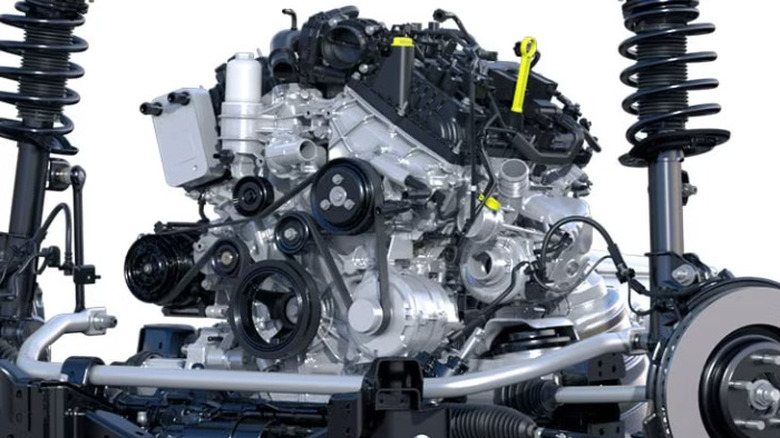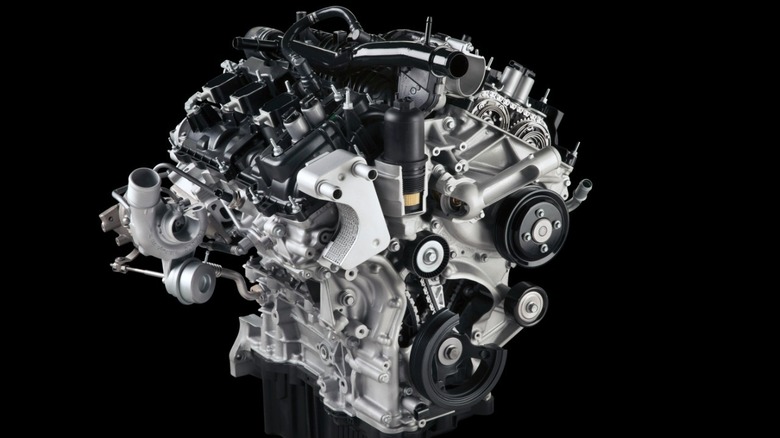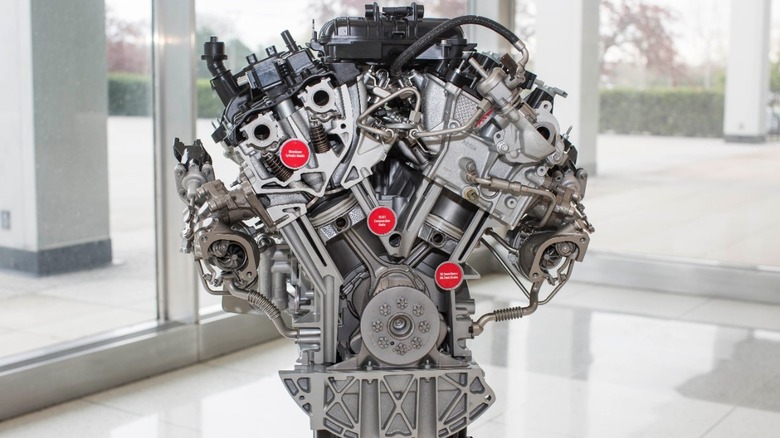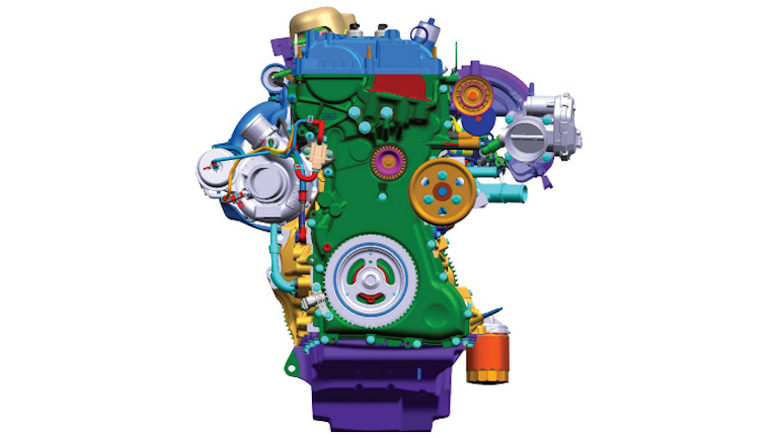Every Ford EcoBoost Engine Ranked Worst To Best
Launched in the 2010's model year, the EcoBoost engine uses a combination of a smaller displacement engine along with direct fuel injection and variable cam timing to maximize fuel efficiency and a turbocharger to add power and acceleration.
The risk Ford took when it introduced the new line of power plants was significant — even more so when the 2015 Ford F-150 was released with a 2.7-liter V6 EcoBoost option when one considers the loyalty Americans have to Ford's F-series of pickups and their traditionally massive V8 engines — but the investment paid off, keeping the company in line with governmental emissions regulations while still offering the power and pickup its drivers demand.
When Ford introduced the EcoBoost lineup in 2009, it featured three options. Today, there's an EcoBoost for every gas-powered vehicle listed on Ford's Showroom website. But not every EcoBoost was created equal. Some had disastrous issues, resulting in discontinuations, redesigns, and recalls. Others are simply known as problematic by mechanics, an otherwise tolerant and optimistic crowd. Let's take a look at the EcoBoost engine lineup and rank these famous — and infamous — developments in the Ford Motor Company's long history.
10. EcoBoost 1.6-liter Sigma
The 1.6 -liter, four-cylinder EcoBoost engine was one of the first out of the gate for Ford, and unfortunately, it was the most infamous of the first wave. Built in Wales, the 1.6 -liter was first used in the C-Max and Focus before being installed in the S-Max in 2012. The Escape, Fusion, and Fiesta ST were added to the list in 2013, and the Transit Connect in 2014. The same engine was also used in several Volvos, as Ford owned that company at the time. However, the 1.6 -liter EcoBoost option was phased out starting in 2016, and by 2019 it was discontinued by Ford.
It wasn't a bad engine, per se — the 1.6-liter EcoBoost topped out at 197 horsepower depending on the application — but several issues plagued this first-gen EcoBoost more than any other EcoBoost engine. From fuel lines that would break to overheating issues resulting in multiple recalls, the 1.6-liter was simply more trouble than it was worth. In fact, one South African man died when his Ford Kuga (that's an Escape here in the States) caught fire and trapped him inside.
9. EcoBoost 1.5-liter Sigma
The 1.5-liter, four-cylinder EcoBoost engine is an interesting entry on our list. Ford announced the 1.5-liter engine at 2013's Shanghai Motor Show, and it was the first expansion of the initial offering of EcoBoost engines. The fact that the 1.5 was debuted in China was no accident — Chinese vehicle tax regulations at the time put any gas-powered vehicles with engines smaller than 1.6-liters in the category of "energy-saving." Ford equipping the 2014 Focus with the new 1.5-liter engine resulted in a subsidy of around $500, along with lower insurance and registration costs.
Unfortunately, even though Ford touted the smaller displacement engine to have improved performance and fuel economy, it was still built on the basic architecture of the 1.6. That meant many of the same issues as its big brother — the block cracked, coolant intrusion occurred, and overheating and catastrophic engine damage followed if the block wasn't quickly replaced.
A class action lawsuit was even brought against Ford in 2020, alleging that the automaker knew about the defects in its first generation 1.5-, 1.6-, and 2.0 -liter EcoBoost engines and did nothing more than provide temporary solutions like the installation of a coolant level sensor. However, a Technical Service Bulletin released in late 2019 shows that Ford did eventually require technicians to replace the entire short block and head gasket to properly repair the damage.
8. EcoBoost 2.0-liter GDI
The first generation of the four-cylinder, 2.0-liter EcoBoost only lasted four years before its replacement was introduced to the world. As a member of the introductory 2010 lineup, it was part of the recalls that plagued the 1.5- and 1.6-liter Sigma four-cylinder engines and had similar difficulties with coolant infiltration. Coolant would work its way into the cylinders, most often through a crack between cylinders two and three, producing white smoke and sometimes blowing the head gasket. If not addressed, engine misfires and full seizing could occur.
Other issues with the first-gen 2.0-liter EcoBoost engine included fuel pump issues and exhaust manifold cracking, which would lead to turbo malfunction as the system uses exhaust pressure to produce additional power and acceleration.
The 2.0 was a workhorse, though, producing up to 200 horsepower and 221 lb-ft of torque in a small, light package. Its eventual redesign as the 2.0-liter Twin Scroll addressed many of the issues with the original four-cylinder EcoBoost's design. More on that updated two-liter engine later.
7. EcoBoost 1.0-liter Fox
The little three-cylinder 1.0-liter "Fox" engine was added to Ford's growing EcoBoost lineup in 2012, although we didn't see it in an American vehicle until a few years later.
A multi-time International Engine of the Year award winner, the 1.0-liter was redesigned in 2017 and added the ability to run on only two cylinders when possible while also improving engine balancing. The Fox engine is a great example of what a smaller powerhouse can do when backed up by the efficient use of a turbocharger and some incredible engineering.
Getting a lot of power — up to 125 horsepower and 150 lb-ft of torque — out of such a small engine wasn't without challenges, though. The "Fox" engine, mostly used in smaller vehicles like the Fiesta and EcoSport, tended to run hot. That fact, coupled with early 1.0-liters having a faulty lower coolant hose that, if left unattended, could allow head gasket and cylinder head issues to develop. That issue was largely resolved, and Ford ate the cost of replacing several of the engines that suffered from this defect.
6. EcoBoost 1.5-liter Dragon
Introduced in 2014, the "Dragon" is considered the evolution of the Fox engine. Ford added cylinder deactivation tech to increase efficiency while combining direct fuel injection (used in most EcoBoost engines) with port fuel injection. The three-cylinder, 1.5-liter engine currently powers some Focus, Escape, Fiesta trims, and the popular Ford Bronco Sport. In the Bronco Sport, the smallish engine delivers a decent 181 horses.
The 1.5-liter "Dragon" is considered very reliable, and the only common issues are the ones all EcoBoosts tend to experience, like carbon buildup and the occasional fuel pump issue. However, a frequent complaint about the 1.5-liter turns one of its features into a bug. The cylinder deactivation technology improves fuel efficiency and makes the engine a bit more eco-friendly, but at the cost of performance, as the engine essentially eliminates 33% of its potential. Still, the benefits of the 1.5L far outweigh the negatives.
5. EcoBoost 2.0-liter Twin Scroll
A significant improvement over the original design, the Twin Scroll is used in dozens of vehicles today and solved a lot (but not all) of the coolant intrusion issues common in the first-gen 2.0-liter engine.
After Ford realized that it had a problem with the first wave of EcoBoost four-cylinder engines, it got to work redesigning them. The 2.0-liter GDI was scrapped for a completely redesigned engine with a higher compression ratio, improved fuel and oil systems, and a twin-scroll turbocharger. This turbo design allows for a more responsive, more efficient operation.
The 2.0-liter EcoBoost is used in several applications, but its most powerful form is in the Ford Maverick, where it produces 250 horsepower and 277 pound-foot of torque. It's also found in the Mondeo and Lincoln Zephyr. While it's generally regarded as a reliable power plant, the twin-scroll 2.0-liter EcoBoost is known for its boost solenoid prematurely failing, resulting in a malfunctioning turbocharger, a check engine light, and a significant lack of power. Fortunately, it's a relatively easy — and inexpensive — DIY fix for you shade tree mechanics out there.
4. EcoBoost 3.0-liter Nano
With a design based on the successful 2.7-liter Nano V6, this 3.0-liter EcoBoost engine has shared the Nano name with its smaller counterpart since its introduction in the 2017 Lincoln Continental. The cylinder bore was increased, the piston stroke was lengthened, and the compacted-graphite construction of the 2.7-liter was replaced with cast aluminum, but much of the architecture remained.
Used in the Explorer ST, the 3.0-liter EcoBoost can get up to 400 horsepower, and the plug-in hybrid that's in the Lincoln Aviator wrings 494 horses and 630 pound-foot of torque out of the relatively small engine. It's considered a very reliable engine, with its only common issue being that older 3.0-liter engines used a plastic oil pan attached to an aluminum block, which tended to leak from the seal between the two materials. A technical service bulletin (TSB) was released instructing technicians to replace that RTV seal with a press-in-place gasket in 2019.
3. EcoBoost 2.7-liter Nano
The "Nano" EcoBoost engine was released into the wild in 2015, where it was one of the power plants available for the Ford F-150. At the time, reviews praised the 2.7-liter EcoBoost for its reasonable price and handling but complained that it didn't sound or feel like a truck engine. Today, the F-150 remains the best-selling pickup truck in the country (and one of SlashGear's picks for best of 2022), and the 2.7-liter EcoBoost engine was included in many of those sales.
By 2018 it underwent a significant redesign, adding port fuel injection to the direct injection system the EcoBoosts are known for. Weight was reduced with a new camshaft, and reliability improved with a stronger dual-chain drive system. The turbo controls were reimagined, EGR was rethought, and even the oil pump was replaced to improve flow and reduce parasitic losses. Ford calls it a "second generation" of the 2.7-liter V6.
As an example of the performance and power the EcoBoost Nano brings to the table, the 2023 Ford F-150 XL uses this 2.7-liter power plant and produces 325 horsepower and 400 pound-foot of torque capable of towing 10,100 pounds.
2. EcoBoost 3.5-liter Cyclone
Ford introduced the EcoBoost via a press release in 2008, and the first engine in the new lineup was the 3.5-liter, twin-turbocharged six-cylinder. It powered the 2009 Lincoln MKS, promising V8 power paired with the fuel efficiency of a V6.
A redesign was introduced to the world at the 2015 Detroit Auto Show, where the new EcoBoost powered the debuting 2017 Ford GT supercar. In 2005, the Ford GT had a 5.4-liter supercharged V8 under the hood, pumping out 500 horsepower and 500 pound-foot of torque. By comparison, the '17 GT, with a six-cylinder 3.5-liter engine, produced a whopping 647 horses and 550 pound-foot of torque.
Several models use the "Cyclone" these days, with the F-150 featuring both a standard EcoBoost delivering 400 horsepower, 500 lb-ft of torque, a tow package capable of pulling 14,000 pounds, and a High Output option for the Raptor that produces 50 more horses and 10 more pound-foot of torque.
While it is a great engine with a variety of applications, the 3.5-liter EcoBoost wasn't without its issues. Timing chain problems were common in the first generation "Cyclone." While Ford solved those issues with the second-gen engine, cam phasers in the new engines caused a noisy rattle for the first three years of its existence.
1. EcoBoost 2.3-liter GDI
The 2.3-liter EcoBoost engine was introduced in 2015, and it's the most powerful four-cylinder engine in the lineup. It started its run in the 2015 Lincoln MKC before being installed in the next model year's Ford Explorer and Focus RS, but it's best known as the powerhouse for the Mustang. When it was announced that the EcoBoost would be an option for the S550 Mustang alongside a 3.7-liter N/A six-cylinder and the 5.0-liter Coyote V8 (in the GT), it caused a bit of a stir among pony car enthusiasts. However, the EcoBoost's 310 horsepower and 320 pound-foot of torque matched the prior model year's much larger 4.6-liter V8.
Newly redesigned for the 2024 model year, the Ford Mustang's EcoBoost engine outputs 315 horsepower and 350 pound-foot of torque. While that's a slight increase from last year's model and nowhere near the 500 horses being pushed out by the 2024 Ford Mustang Dark Horse's 5.0-liter V8, it's still respectable for a turbocharged four-banger. The 2.3-liter engine is also in some of Ford's more popular vehicles, including the Explorer, Everest, and Bronco.
It's hard to find fault with the 2.3-liter EcoBoost. It, of course, shares the carbon buildup issues that all EcoBoosts have — that's part of the deal with a direct-injection system — but compared to the problems we've already discussed with other engines, that's barely an inconvenience. Early versions had some issues stemming from the exhaust getting hotter than expected, but some heat shielding took care of that.
